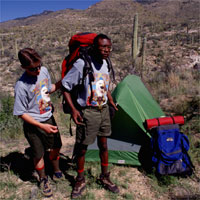- Quick Concept for Travel and Camp On Durable Surfaces
- Activity Plan 1 for Travel and Camp on Durable Surfaces – Exploring Travel Concepts
- Download Alpine Setting Scenario Activity Sheet
- Download Desert Setting Scenario Activity Sheet
 Exploring Campsite Selection
Exploring Campsite Selection
This activity will take about 45 minutes.
What Your Group Will Learn
After participating in this activity plan, which is designed to help participants learn about campsite selection, participants will be able to
- Determine the best location for a campsite.
- Apply Leave No Trace ideas to campsite selection decisions.
Your group will use a sketch of a heavily used alpine area and one of a pristine desert area to help them decide the best location for setting up a campsite. The sketches will provide a focal point for questions and discussions.
Materials and Preparation
Materials
- A copy of the two scenario activity sheets for each person (download the .PDF files.)
- Small adhesive-backed colored dots to simulate tents (Each person should have the same number of dots as the group would have tents, assuming one tent per two people—10 campers, five dots.)
Preparation
- Read the entire activity plan and the Background on the Principles of Leave No Trace thoroughly.
- Photocopy one scenario activity sheet and drawing for each participant. The photocopies should be one-sided to permit easy reference by the participants. Photocopying drawings in two different colors makes referring to the scenarios even easier (i.e., alpine backcountry—green; desert—buff).
- Purchase dots.
Grabbing Your Group’s Attention (5 minutes)
Distribute Scenario 1—Alpine Setting—Alpine Backcountry, and Scenario 2—Desert Setting—Desert Backcountry. Have participants compare the two drawings and share what they observe about the two scenes. In what ways are they similar? In what ways are they different? Explain that they will use these two drawings to make decisions about how to choose the best campsite in an area that has experienced heavy visitation and in an area that has experienced little or no visitation.
Steps for Teaching the Activity (30 minutes)
Scenario 1: Alpine Setting
1. Distribute Scenario 1—Alpine Setting Activity Sheet.
2. Divide the group into teams of three or four. Tell them that each group is part of a larger group on a trip to a primitive area. Before starting the activity, each group should determine the size of the larger group, keeping in mind that this wilderness area allows no more than 10 campers per group.
3. Distribute the tents (dots) to each group. Assume two people will share one tent: 10 backpackers 5 five tents (dots).
4. Review the directions for scenario 1 and have participants complete the activity.
A close review of the Background on the Principles of Leave No Trace is needed to effectively lead the following discussion.
Where would you advise your group to camp? Most people will choose an established campsite. Discussion should focus on choosing a site that will protect the land and help prevent new impact to the area.
Why is camping close to a lake or stream not an acceptable option? Discussion should focus on protection of riparian zones, the fragile, green area along the bank of the stream, on water contamination, and on scaring wildlife from approaching the stream for a drink. Also, sound carries across open bodies of water.
Rearrange the tents (dots) if the discussion causes participants to change their minds. Have participants explain the reasons for their changes. Summarize key points for heavily used areas.
- Camp 200 feet or more from lakes, streams, meadows, and trails.
- Select campsites that are already well-established and properly located.
- Confine most activities to the areas of the site that are already established.
- Choose sites that comfortably fit your entire group without creating a new site.
Scenario 2: Desert Setting
Distribute Scenario 2—Desert Setting Activity Sheet. Repeat steps 2 through 4 listed under scenario 1.
A close review of the Background on the Principles of Leave No Trace is needed to effectively lead the following discussion.
What areas will your group select for a campsite? Most people will choose the most durable surfaces, such as flat rocks or sandy areas free of cryptobiotic soils. Discussion should focus on use of durable surfaces, on dispersal of activities, and on alternative routes to and from locations.
Rearrange the tents (dots) if the discussion causes participants to change their minds. Have participants explain the reasons for their changes. Summarize key points for pristine areas.
- Choose a nonvegetated, highly resistant surface for tents and kitchens.
- Choose durable routes of travel between parts of camp.
- Avoid cryptobiotic soils.
- Limit your stay to no more than two nights.
Wrapping Up the Activity (10 minutes)
Your campers have practiced how to select campsites that will preserve the naturalness of the outdoors for wildlife and visitors. How well have they learned their lesson?
Have participants imagine they are on a backcountry trip and their leader has selected a campsite 50 feet from a stream. Your group has learned about the criteria for proper campsite selection.
Given what they know:
- How will the group communicate with their leader concerning this problem?
- How will group members prepare their tent sites? Will they remove rocks, twigs, or leaves?
- What steps can be taken to minimize the impact of selecting and using a tent site?
Refer to the Background on the Principles of Leave No Trace for answers.
Congratulations on conducting a well-prepared meeting for your group!
 Exploring Campsite Selection
Exploring Campsite Selection